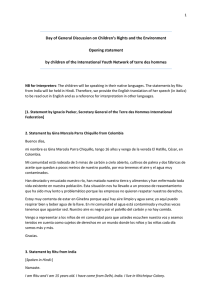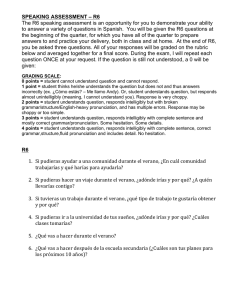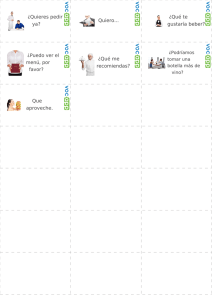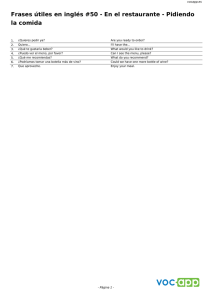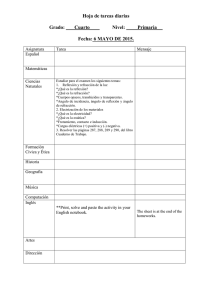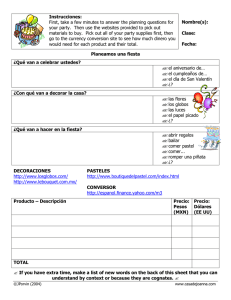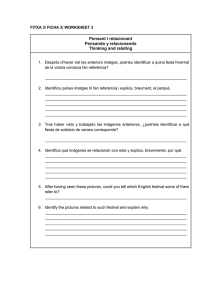Community Assessment Toolbox
Anuncio
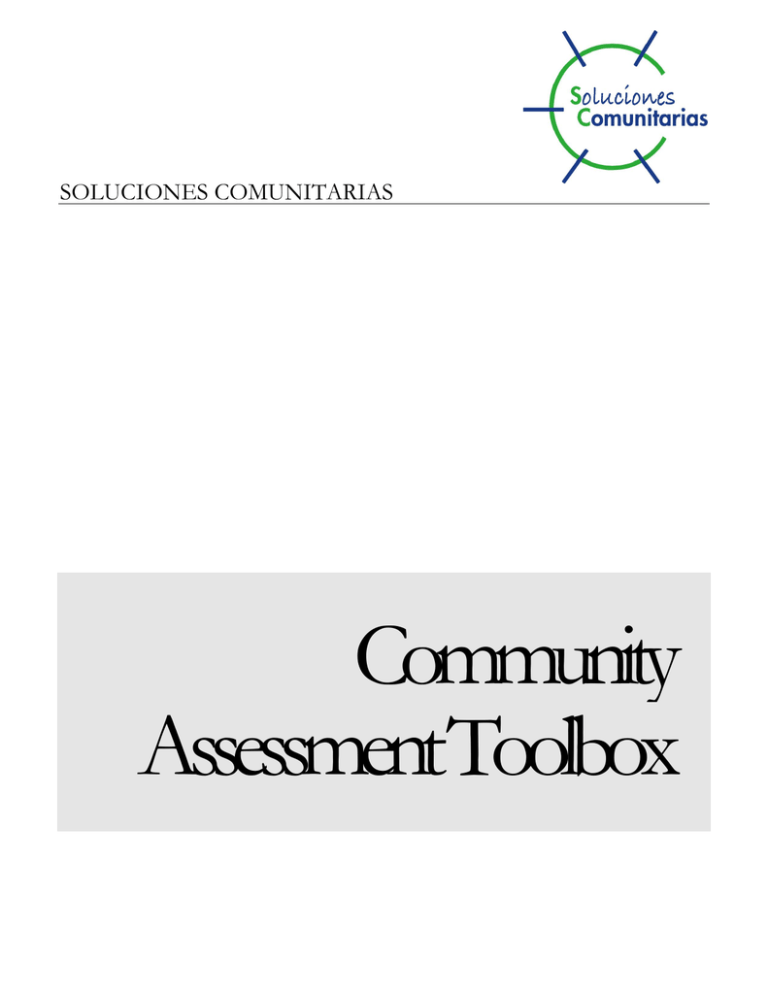
SOLUCIONES COMUNITARIAS Community AssessmentToolbox Contents Acknowledgements ................................................................................................................. 1 Introduction ............................................................................................................................. 2 Introductory Script ........................................................................... 2 Summary of Tools ................................................................................................................... 3 Surveys ........................................................................................... 3 Interviews ........................................................................................ 3 Focus Groups .................................................................................. 3 Village Imaging ................................................................................ 3 The Peer Method ............................................................................. 3 Community Interaction .................................................................... 3 Surveys ................................................................................................................................... 4 Información demográfica ................................................................. 5 Necesidades comunitarias .............................................................. 6 Agua limpia ...................................................................................... 7 Salud de ojos ................................................................................... 8 Uso de estufas ................................................................................ 9 Interviews .............................................................................................................................. 10 Formal Interviews .......................................................................... 10 Formal Interview Questions ........................................................... 10 Focus Groups ........................................................................................................................ 11 Conducting a Focus Group ........................................................... 11 Facilitator Outline .......................................................................... 11 Focus Group Discussion Questions .............................................. 12 Resumen de Grupo de Enfoque .................................................... 13 Village Imaging ...................................................................................................................... 14 How to Conduct Village Imaging ................................................... 14 Example Village Imaging Drawing ................................................. 14 Potential Follow-Up Question(s) .................................................... 15 The Peer Method .................................................................................................................. 16 Peer Method Basics ........................ Error! Bookmark not defined. Forma de información del método de compañeros ....................... 17 Community Interaction .......................................................................................................... 18 How to Summarize Data ....................................................................................................... 19 General Summary Outline ............................................................. 19 Summary Form .............................................................................. 20 S O L U C I O N E S C O M U N I T A R I A S Acknowledgements The following guide was developed for Community Enterprise Solutions / Soluciones Comunitarias by a group of dedicated interns from the University of Maryland in close collaboration with field staff and local organizations in the Dominican Republic. The students include: Brandon Draper, Leslie Joy, Andrew Tlsty, Benay Walker, Tatyana Williams, and Ellen Yu. Portions of the guide are in Spanish, and the full Spanish version is also available. For questions or comments, please contact a member of the Community Enterprise Solutions team: Kaylynn Palaio Field Consultant – Dominican Republic kpalaio@cesolutions.org 1-829-826-2778 1 S O L U C I O N E S C O M U N I T A R I A S Introduction The tools in this manual are designed to discover the needs and assets within a community. By using these tools, one will likely discover issues or needs that Soluciones Comunitarias cannot address. As such, it is important to clarify the purpose of these tools. One must explain to community members that discussing a need during the use of these tools does not signify that the need will be met by Soluciones Comunitarias. Introductory Script Before conducting a community assessment using any of these tools, introduce yourself and Soluciones Comunitarias using the script below. Introduce Yourself Hello, my name is ___________. I work with the organization Soluciones Comunitarias. Introduce Soluciones Comunitarias This is an organization that works within communities in Latin America to bring inexpensive access to resources such as reliable light, clean water, efficient fuel sources, and things such as this. It achieves this goal through the sale of products which promote general wellbeing, such as solar lamps, water filters, cookstoves, eyeglasses, as well as other products. Explain Why You Are Here The purpose of me being here today is to inquire into the needs and assets of this community. The information that I gather today will help Soluciones Comunitarias to better serve this community. However, just because a need is discussed today does not mean that Soluciones Comunitarias will be able to meet the need. I would like to thank you [you all] for coming, and thank you for having me today. [Begin implementing the tool.] 2 S O L U C I O N E S C O M U N I T A R I A S Summary of Tools Surveys There are numerous surveys available which can be distributed amongst communities. Surveys are not particularly time consuming and are a useful method for quickly gathering information from multiple sources with minimal effort. After collecting the completed surveys, the Asesor Comunitario can review the information provided on the survey and extract useful information. Interviews Interviews are a helpful method to get in-depth information about a community from a single source. By conducting interviews with several members of the community, multiple perspectives on a community can be gathered. Focus Groups A focus group consists of six to ten people, and is meant to be a focused discussion about a community's assets and maladies. Groups should be as homogenous as possible, and multiple focus groups of different types of people should be held in the same community. Village Imaging Village imaging consists of sitting down with a community member and asking them to draw their community on a piece of blank paper. After drawing their community, a conversation about the contents of the drawing is initiated in order to discover any resources or obstacles in the community. The Peer Method The Peer Method is a community assessment tool designed to have members of the community gather information and report it back to the Asesor Comunitario. It is a method that requires a moderate time commitment and gathers a large amount of information if conducted properly. Community Interaction Community interaction involves participating in local activities in order to develop a relationship with the community members. A strong relationship will allow the entrepreneur to more accurately discern the needs and assets of the community. 3 S O L U C I O N E S C O M U N I T A R I A S Surveys Surveys are tools which can gather significant information with very little effort. Below are numerous surveys which can be used to assess communities. Asesores Comunitarios are encouraged to create additional surveys in order to target more specific issues in the communities in which they work. Medium-Length Surveys Información demográfica Necesidades comunitarias Short Surveys Agua limpia Salud de los ojos Uso de estufas 4 S O L U C I O N E S C O M U N I T A R I A S Información demográfica Nombre: ___________________________________________ Edad: _______ Género V H Status: ________________ Ocupación: ___________________________________________ ¿Cuantas personas hay en su familia? ¿Cuántos hijos tiene? ¿Y cuántos años tiene? ¿Cuantos de sus hijos van a la escuela? ¿Cuantos de sus hijos trabajan? ¿De qué se ocupan? ¿En que trabaja su esposo/a (si está casada/o)? ¿Cuánto ganan entre todos en la casa? ¿Es esto suficiente? ¿Cuantas personas viven en su casa? ¿Cuantas habitaciones tiene su casa? ¿Hay electricidad en su casa? ¿Tiene agua corriente en la casa? ¿Es el agua potable? ¿Si no, que hace para purificar el agua para su familia? ¿Tiene terreno para su propia huerta? ¿Cómo y dónde cocina? ¿Cuáles son sus deseos a corto, mediano y largo plazo? Corto: Mediano: Largo: 5 S O L U C I O N E S C O M U N I T A R I A S Necesidades comunitarias Nombre: ___________________________________________ Edad: _______ Género V H Status: ________________ Ocupación: ___________________________________________ ¿Hay muchas personas aquí que reciben un salarió fijo? ¿Cuáles formas de trabajo ofrecen la oportunidad de recibir un salarió fijo? ¿Cómo son las normas de pagamento? Para las personas que no reciban un salario constante, ¿Cuándo hay más oportunidades de trabajo temporal? ¿Cuáles son estas fuentes de trabajo? ¿Cómo los miembros de la comunidad adquieren agua para tomar? (filtros, botellones, otra) ¿Cuánto gastaría una familia típica en comprar agua por semana? ¿Cuáles son las necesidades más profundas en la comunidad? ¿A qué más falta acceso la comunidad? ¿Cuáles son los problemas de salud más común en su comunidad? ¿Cuáles grupos comunitarios u organizaciones son más activos en la comunidad? ¿A qué se dedican? ¿Y qué hacen principalmente? ¿Quiénes son los líderes de estas organizaciones? ¿Hay algún proyecto comunitario que una organización está lanzando o que quisiera lanzar? Por favor, descríbalo. A quién contactaríamos si quisiéramos aprender más? ¿Quién es el punto de contacto? 6 S O L U C I O N E S C O M U N I T A R I A S Agua limpia Comunidad __________________________________ Edad _____ Género V H ¿Cuantos personas viven en su casa? ¿Ahora, cuál es su manera para obtener agua pura? ¿En una escala de uno a cinco, como se clasifica su manera de obtener agua pura? ¿Por qué? 1--------------------2--------------------3--------------------4--------------------5 difícil mediano fácil ¿Cuál es su gasto actual para agua por semana? 7 S O L U C I O N E S C O M U N I T A R I A S Salud de ojos Comunidad __________________________________ Edad _____ Género V H Por lo general, ¿cuántas horas pasa en el sol cada día? ¿Pasa tiempo en áreas con mucho viento o mucho polvo? ¿Protege sus ojos cuando está en áreas con mucho sol, viento, o polvo? En cocinar, ¿Los ojos se irritan por el humo? ¿Ha notado un cambio en su capacidad de ver? 8 S O L U C I O N E S C O M U N I T A R I A S Uso de estufas Comunidad __________________________________ Edad _____ Género V H ¿Por cuántas personas se cocina? ¿Cuántas veces necesita usted usar una estufa en un día? ¿Qué es su corriente método de cocinar? En una escala de 1 a 7, ¿cómo se siente usted sobre su método de cocina? Fuertemente Aversión Fuertemente Disfrutar 1 ---------- 2 ---------- 3 ---------- 4 ---------- 5 ---------- 6 ---------- 7 ¿Cuál es su método de cocina preferido? (Leña/Gasolina/Electricidad/Carbón) ¿Por qué es este su método de cocina preferido? 9 S O L U C I O N E S C O M U N I T A R I A S Interviews Interviews are useful methods to gather in-depth information on a community. They can be conducted formally or informally. This means that the interview can consist of sitting someone down with a clipboard and questions or initiating a casual conversation with someone about their community. In both cases, the interview should behave as a conversation rather than one person asking questions and the other answering. The goal of the interview is to gain insight into the assets and liabilities within a community. A large number of interviews should be conducted in a single community with a large range of demographic groups. Formal Interviews To conduct a formal interview, one must enter a community and knock on doors asking for interviews. The list of questions and follow-up questions below can be used to lead formal interviews. All of these questions can be followed with a conversation in order to delve deeper into any issues or assets that persist in the community. Formal Interview Questions What are you most proud of in your community? What does your community do best? What resources or technology would help you take it to the next level? How would you refine/develop/facilitate the process? Identify assets in your community. Where do you see your community in five years? Is there anything that you wish you could change about your community? Identify issues in your communities. Describe some difficulties you encounter at work, at home, and during leisure time. What technology would you like in to have in your community? Why? How would it improve your life? Could it also benefit the community/those around you? Do you see your neighbors struggling with anything? 10 S O L U C I O N E S C O M U N I T A R I A S Focus Groups A focus group is a guided discussion in which a facilitator (Asesor Comunitario) asks questions and then observes the group of community members speaking about their experiences. The facilitator is a guide who provokes discussion. A focus group should not be a question and answer session, but rather a dialogue amongst all members of the group. Conducting a Focus Group To conduct a focus group, one must first gather five to ten community members. These community members should be of the same demographic group, such as mothers, field workers, teenagers, etc. After gathering members of the focus group, the AC should follow the Facilitator Outline below. Facilitator Outline 1. Opening Remarks ○ Explain the purpose of the focus group. ○ Explain the purpose of focus groups. ○ Encourage disagreement and debate. ○ Clarify that no consensus needs to be reached. ○ Facilitator must be neutral and serve as a guild for the direction of the discussion. 2. Introductions ○ Invite members to introduce themselves and describe their role or relation to the focus group topic. ○ Have each person speak at least once. ○ Create safe environment for ideas. 3. Leading the Focus Group ○ Build on initial questions with follow-up questions to further discussion. ○ Stay on track, but diverge when a relevant conversation path emerges ○ Connect emergent data. ○ Ensure that all participants who want to comment on a question or discussion topic have the opportunity to contribute. 4. Closing ○ Signal that discussion will end soon. Allow for enough time to come to a stopping point on current topic. ○ Identify key themes that emerged from discussion. ○ Identify contrasting perspective along with areas of agreement. ○ Allow for a round of final comments. 11 S O L U C I O N E S C O M U N I T A R I A S Focus Group Discussion Questions Use this page as a guide for creating discussion. Take appropriate notes on the discussion and dig deeper into the discussion with the given follow up questions. These questions are meant to be a guide. Do not use these questions exclusively when conducting a focus group. Develop your own questions to ask along with the ones below. What are you most proud of in your community? What does your community do best? What resources or technology would help you take it to the next level? How would you refine/develop/facilitate the process? Identify assets in your community. Where do you see your community in five years? Is there anything that you wish you could change about your community? Identify issues in your communities. Describe some difficulties you encounter at work, at home, and during leisure time. What technology would you like to have in your community? Why? How would it improve your life? How could it benefit the community/those around you? Do you see your neighbors struggling with anything? Notes DO NOT conduct a focus group with more than ten people. Groups larger than ten become impossible to manage. It is sometimes helpful to have the group members pass around a ball. Only the person with the ball is permitted to speak. It is important that an effort is made to have every group member talk. Focus groups can be conducted in pairs with one person facilitating the group and the other taking notes. 12 S O L U C I O N E S C O M U N I T A R I A S Resumen de Grupo de Enfoque Nombre: ____________________________ Comunidad: _____________ Fecha: _______ Brevemente anote la información demográfica de su grupo de enfoque: Número de varones: _____ Rango de edad: _____ Número de hembras: _____ Edad promedio: _____ Ocupación general (¿a qué se dedica?): _________________________ ¿Cuáles fueron las principales preocupaciones planteadas por miembros de la comunidad? ________________________________________________________________________ ________________________________________________________________________ ¿Qué identificó el grupo de enfoque como ventajas? ¿Había métodos o ideas discutidas para mejorar o ampliar estas ventajas? ________________________________________________________________________ ________________________________________________________________________ ¿Cuáles tópicos o preguntas solicitaron lo más discusión y debate? ¿Fueron conclusiones significativas hecho? ________________________________________________________________________ ________________________________________________________________________ ¿Les preguntó usted algunas preguntas que no estaban en la lista? ¿Qué le gustaría compartir con otros asesores de SOLCOM para grupos de enfoque en el futuro? ________________________________________________________________________ ________________________________________________________________________ ¿Cuáles sugerencias sobre mejoramiento de la comunidad se hicieron? ________________________________________________________________________ ________________________________________________________________________ Después de reflexionar sobre el grupo de enfoque de hoy, ¿cuáles son algunas perspectivas que usted ha aprendido? ¿Tiene más preguntas para la comunidad? ________________________________________________________________________ ________________________________________________________________________ ¿Cómo puede una organización, como el Cuerpo de Paz, apoyar esta comunidad? ________________________________________________________________________ ________________________________________________________________________ 13 S O L U C I O N E S C O M U N I T A R I A S Village Imaging Village imaging is a tool in which a community member is asked to draw diagrams of their community as they see it so assessors can identify assets, problems, and potential solutions for those problems. Village imaging should be conducted on numerous community members of different demographic groups in order to gain a variety of perspectives on the community. How to Conduct Village Imaging 1. Give the community member a blank sheet of paper and three colors of pencils or markers. 2. Instruct the community member to draw his or her community. • Very little instruction should be given at this step. Without guidance, the community member will draw what is most important to them within their community. • Instruct the community member to label items drawn on his or her map (if possible). 3. Ask the community member to quickly describe the contents of the drawing. 4. Instruct the community member to use a different color to circle items as assets. • Ask questions to discover deeper assets • Use the list of follow up questions below to aid in this step 5. Instruct the community member to use a different color to circle items as issues. • Ask questions to discover deeper needs • Use the list of follow up questions below to aid in this step Example Village Imaging Drawing 14 S O L U C I O N E S C O M U N I T A R I A S Item Drawn Potential Follow-Up Question(s) Animals Banca Businesses Church Colmado Houses Are the animal products utilized within the community? How? Do they sell the animal products to people outside of the community? What product/service do you wish your banca provided? Who does the business serve? Does the community benefit from this business? What are some things that could help this business thrive? What does your church do to benefit the community? How often do you visit the colmado? Describe a trip to the colmado. What do you end up getting? Does the colmado always have what you want? What you need? What product/service do you wish your colmado provided. How far are you located from your neighbors? Can you hear music playing out of their houses on a regular basis? Is this a close-knit community? River What are the current uses of the river water? Is the water safe to drink? If not, how do people obtain safe drinking water? Roads Which road is the most traveled? Are the roads in good condition? School To which grades does the school cater? How many students/staff attend the school? Does this school have a half day or a full day? Does the school usually receive funding on time? Trees How many trees are in the community? Do the trees produce a lot of fruit? Is the wood used as firewood? Notes Try to avoid leading questions or suggestions about products. The objective is not to pitch products to the community member, but to gather information about the needs and assets of the community. When you use this tool on multiple people, you can compare responses and ask questions based upon what people do or do not include on their map. On a separate sheet of paper, keep notes about the discussion. This should include the assets and liabilities that were pointed out by the community member. 15 S O L U C I O N E S C O M U N I T A R I A S The Peer Method The Peer Method consists of gathering three community members who will act as consultants for the Asesor Comunitario. Each week, a different topic will be chosen for the consultants to discuss with their peers in the community, and the AC will meet with the community consultants to discuss the findings from the previous week. Selecting Consultants To maintain a more focused path towards gathering information, it is important to have three consultants of the same demographic group. Multiple groups of consultants of differing demographics should be operating in each community in order to gain different perspectives on any one issue. Selecting Weekly Topics The weekly topic on which the consultants focus should be chosen based upon what is deemed most useful upon entering a community. These topics are chosen such that the results of the assessment provide insight into a community’s assets and liabilities, as well as to increase general awareness and education. Los básicos del método de compañeros - Obtain three consultants from the same demographic group - Pick a theme for the week - Instruct the consultants to discuss the theme with their neighbors, friends, and family during the week. - Touch base with the consultants after the week to debrief. Notes The Peer Method requires the trust of the community in order to work effectively. The consultants chosen must be respected members within their demographic group. Potential Demographic Groups Children Teens Mothers Fathers Field Workers Teachers Electricity/Lights Food and Cooking Literacy Sexual Education Roads and Construction Health Potential Weekly Topics Water Sanitation and Hygiene Internet Access 16 S O L U C I O N E S C O M U N I T A R I A S Forma de información del método de compañeros Nombre: ____________________________ Comunidad: _____________ Fecha: _______ Consultores Nombre Edad Género V H V H V H Grupo demográfico de consultores: _________________________________________________ Tema de la ______________________________________________________________ semana: Información aprendida ______________________________________________________________________________ ______________________________________________________________________________ ______________________________________________________________________________ ______________________________________________________________________________ ______________________________________________________________________________ ______________________________________________________________________________ ______________________________________________________________________________ ______________________________________________________________________________ ______________________________________________________________________________ ______________________________________________________________________________ ______________________________________________________________________________ ______________________________________________________________________________ ______________________________________________________________________________ ______________________________________________________________________________ ______________________________________________________________________________ ______________________________________________________________________________ ______________________________________________________________________________ ______________________________________________________________________________ ______________________________________________________________________________ ______________________________________________________________________________ ______________________________________________________________________________ 17 S O L U C I O N E S C O M U N I T A R I A S Community Interaction Community interaction is a very helpful informal method of gathering information on a community. This consists of participating in community activities, such as going to church, attending neighborhood group meetings, participating in community fiestas, etc. Interacting with a community in this informal setting will help to form a relationship with the community and will ultimately allow for a wider impact from the products that are sold within the community. By familiarizing yourself with a community, you are able to develop more personalized and pertinent suggestions for community improvement. 18 S O L U C I O N E S C O M U N I T A R I A S How to Summarize Data After using the tools in this manual to gather data, it is important to create a summary which reflects the needs and assets of the community. This summary should be concise and should clearly convey the information learned about the community in which the assessments took place. Summaries will be submitted to SolCom at the monthly meetings that are held with the SolCom field consultants. General Summary Outline A written summary which includes the following should be completed. Additionally, the summary form below should be filled in as accurately as possible. Any suggestions for the improvement of the tools in this manual should be written down formally and given to the SolCom field consultant in your region. Community Overview • Size of community • General income information • Type of jobs of people in the community • Health/sanitation information o How many houses have clean drinking water? o How do houses purify their drinking water? o Do houses have access to soap/shampoo/etc.? • Accessibility of community (How to get there; Difficulty of travel) • Other general community information o How many houses use SolCom products (solar lamps / cookstoves / etc.)? o Other information List of Community Assets • Nearby rivers • Access to electricity/potable water • Strong local business/economy • Etc. List of Community Needs • Access to electricity/potable water • Job availability • Fuel sources • Etc. Suggested Products • Create a list of products in SolCom’s catalog that would be successful in this community. • Create a list of products which are not in SolCom’s catalog that would be successful in this community. Issues that SolCom cannot presently address • Create a list of needs of the community that are not met by SolCom products 19 S O L U C I O N E S C O M U N I T A R I A S Summary Form Population Size _____________ Median Age Median Income _____________ Primary Income Source _____________ Percent Children _____________ Percent Female Electricity in Most Houses? Yes / No _____________ _____________ Clean Water in Most Houses? Yes / No Significant Needs _____________________________________________________________________________________ _____________________________________________________________________________________ Significant Assets _____________________________________________________________________________________ _____________________________________________________________________________________ 20
